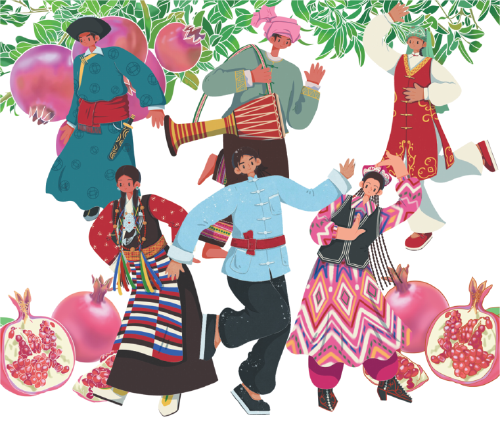
JIN DING/CHINA DAILY
Sept. 27, 2024 -- Fostering solidarity among the 56 ethnic groups of the country to maintain social harmony and realize collective progress is a key aspect of China's socioeconomic policies and cultural integration efforts. The strategy is in line with Chinese modernization, which is aimed at fostering a strong sense of community for the Chinese nation among the different ethnic groups as well.
Ethnic unity and progress, especially in multi-ethnic societies, play a crucial role in a country's development and its efforts to build a strong and harmonious society. Ethnic unity helps create a unified national identity among the people, instilling in them a strong sense of allegiance to the nation, and helping diverse groups to bond under a common national framework. In addition, ethnic unity-driven development can add to the legitimacy of the political system by making all ethnic groups feel represented and valued.
A socially inclusive country can more easily improve governance and reduce political dissent, while an ethnically-united, harmonious society can attract more investments and facilitate collaborative economic activities. However, ethnic unity does not mean the erasure of ethnic identities or cultural diversity but rather their integration into a broader national culture.
China has been home to many ethnic groups for millennia. Today's multi-ethnic Chinese society is the result of the historical conflicts and integration efforts. True, ethnic tensions and regional disparities increased when Western imperialist powers began putting increasing pressure on China after sensing that the Qing Dynasty (1644-1911) was on the decline. But the sociopolitical development also prompted socially conscious forces to accelerate their integration efforts.
In the 20th century, China underwent significant political and social transformations, including the founding of the People's Republic of China in 1949. Shortly after the founding of New China, the higher authorities allowed the ethnic minority groups in ethnic autonomous areas to manage the local affairs and preserve their cultural practices while maintaining overall national unity.
The launching of reform and opening-up in 1978 led to rapid modernization and increased interactions between different regions and ethnic groups, with the migration of people from rural areas to cities in search of better-paying jobs, along with the development of urban areas, contributing to greater cultural exchanges and social integration among different ethnic groups.
The Chinese government has been making efforts to balance economic development and preservation of ethnic identities, in order to consolidate ethnic unity and address regional disparities. The government places emphasis on national pride and harmony, while promoting a sense of shared destiny among all ethnic groups.
Generally speaking, ethnic unity and progress promote social harmony and reduce potential sources of conflict, facilitating smoother social changes. To achieve this, the government has been adopting policies to reduce inequalities and foster mutual respect.
China needs a stable domestic environment to further widen its global influence, serve its increasing strategic interests, and project its power and engage in international relations. In the light of geopolitics, ethnic unity and progress help maintain internal stability.
To better foster ethnic unity and progress in the new era, the government has implemented targeted development programs, including infrastructure projects, poverty alleviation initiatives, and investment incentive practices in regions, such as the Xinjiang Uygur autonomous region and Xizang autonomous region, with relatively large ethnic minority populations.
The government has also taken measures to ensure that members of all ethnic minority groups have access to social services and healthcare, and can get gainful employment, while implementing laws to protect the rights of ethnic minorities and carrying out campaigns to promote unity and patriotism among ethnic minorities.
The pursuit of Chinese modernization has promoted a common national identity among the 56 different ethnic groups. By recognizing the unique features of each ethnic minority group while laying emphasis on a shared Chinese identity, the government has fostered a sense of belonging among them, leading to cultural integration.
To consolidate ethnic unity while building a modern state, the government has to first foster a unified sense of national identity; use narratives that highlight the contributions of different ethnic groups to China's history and development, forging a sense of shared destiny; and promote civic education that emphasizes national unity as well as the value of diversity, so individuals can understand their respective roles in the broader national context.
And second, the government also needs to create and support initiatives that encourage interactions and collaborations among different ethnic groups, such as initiating joint community projects and holding cultural festivals, intensifying campaigns that highlight shared values and common goals, and celebrating ethnic diversity, while continuing to invest in infrastructure, education and healthcare in areas with relatively large ethnic minority populations to reduce disparities and stimulate local economies, and promote entrepreneurship among ethnic minority communities.
The author is a professor, a researcher on social governance and borderlands studies, at the China National Academy of Governance.
The views don't necessarily reflect those of China Daily.


